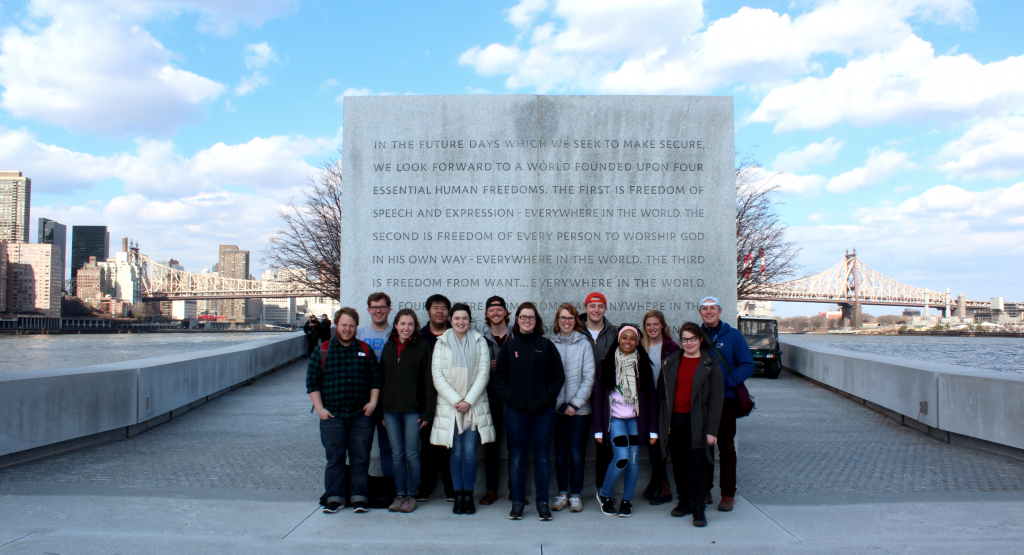A Look at What Makes a Great Urban Park System
Writer / Dan Jones
Photographer / Olivia Brooks Sailor
Each year, the Honors Program at the University of Louisville schedules two travel seminars, one international and one domestic. This year, they invited me to submit a class for the domestic seminar, and I was honored to teach “The Park and the City,” a class looking at what makes a great urban park system and the ways in which great parks shape great cities. While almost every class during our time in Louisville was in a park, over spring break we traveled to New York City to experience the beginnings of the modern urban park movement — in Frederick Law Olmsted and Calvert Vaux’s Central Park and Prospect Park— as well as more contemporary park innovations, such as Paley Park, the Seagram’s Plaza, the High Line and Brooklyn Bridge Park.
Louisville, it turns out, is a great place to teach such a course. We have one of only four complete original systems designed by Frederick Law Olmsted, Sr.—Cherokee, Iroquois, Shawnee and connecting parkways — illustrating the mature artistry and urban vision of the founder of landscape architecture. We also have Waterfront Park, where George Hargreaves made his reputation, which is widely regarded as one of the early, successful uses of a large park to revive the urban core, and finally, The Parklands of Floyds Fork, the largest new, fully-funded metropolitan parks project in the nation.
The class centers on the close relationship between great cities and their parks, beginning with the concept of parks as “city-shaping infrastructure.” One of Olmsted’s great insights was that park planning — often the gift of European noblesse oblige in the Old World — should be made intentional and that any modern city would not be livable without high-quality, maintained public parks accessible to all. Beginning with Central Park, but soon expanding all over the U.S. (similar movements were occurring in places like Paris with Baron Haussmann’s overhaul of the Parisian urban core), Olmsted created a movement, and New York and Louisville, along with many other cities, were its beneficiaries.
The remarkable thing about Central and Prospect Parks, which formed the core of our trip, is that, like Louisville’s Olmsted Parks, they were designed ahead of the growth of the city, giving the designers the room, and freedom, to design large parks with many amenities. When Central Park was laid out, it was far north of the densely settled edge of Manhattan, yet they had the temerity to name it “central” park. When Olmsted came to Louisville in the early 1890s, his parks were laid out far beyond the edge of the city. Today, The Parklands offers this same opportunity for Louisville to shape both the geography of our urban edge in new ways around green infrastructure and also to shape our community’s future around health, education, environmental sustainability and quality of life, while accommodating the future growth of our city.
In New York, we also looked at parks that were intended to shape already developed parts of the city. The modernist jewel of Paley Park, located on 53rd Street between Madison and 5th Avenue, is often described as one of the “finest urban spaces in the U.S.,” despite being only 4,200 square feet in area.
Designed as a quiet space in the madness of midtown, my students were amazed, as I’ve been ever since I first went there as a child, at the power of such a small space. The High Line and Brooklyn Bridge parks both take old industrial ruins — one an elevated train line to the old Meatpacking District in Manhattan, the other the remnant docks of Brooklyn’s waterfront — and create great architectural spaces that have revolutionized the neglected and disused neighborhoods around them, both of which are now flourishing again.
The message of the class is that the benefits of urban parks are widespread, and often impact far beyond their borders. We like to talk about the “6 pillars” of a great urban park system: community, recreation, environment, quality of life and economic development, health and education. All of the parks we saw in both Louisville and New York brought home the power of parks to shape neighborhoods and cities. In New York in particular, with its intense energy and hustle, my students were stunned by the variety of parks and their ability to provide peace and relief within their borders.
The last message of the course is that the 21st Century will be an urban century, and places like the favelas of Brazil, or the slums of Mumbai, are historically analogous to the tenements of the Lower East Side in Manhattan when Olmsted was designing his great parks. We don’t have to reinvent the wheel of urban planning to know that Olmsted’s lessons still apply: those emerging cities that build great park systems will be livable and prosperous. Those that don’t will regret it and will undertake the difficult and expensive work of retrofitting parks.
The lessons we’ve learned in the design and building of The Parklands are lessons I hope to share, through classes like my honors seminar, through our consulting business and through partnerships with new projects around the country and around the globe.
The author would like to thank the UL Honors Program for their wonderful students and the opportunity to travel to NYC.
We appreciate your love of The Parklands and the role you play in the success of this donor-supported public park. A gift to The Parklands not only helps to maintain our parks today, but your continued support will positively shape the future of Louisville and truly benefit current and future generations through access to world-class parks. To donate, please visit theparklands.org/Member. 21st Century Parks is a 501c3 organization, and all gifts are tax-deductible.







